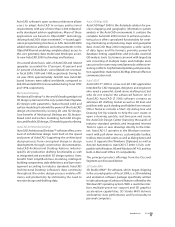Autodesk 2000 Annual Report Download - page 19
Download and view the complete annual report
Please find page 19 of the 2000 Autodesk annual report below. You can navigate through the pages in the report by either clicking on the pages listed below, or by using the keyword search tool below to find specific information within the annual report.
18 FY 00 Autodesk, Inc.
Autodesk’s business and consolidated results of oper-
ations. Additionally, slowdowns in any of Autodesk’s
geographical markets could also harm Autodesk’s busi-
ness and consolidated results of operations.
Product returns,consisting principally of stock rotation,
are recorded as a reduction of revenues and repre-
sented 5 percent, 4 percent and 6 percent of consoli-
dated net revenues for fiscal 2000, 1999 and 1998,
respectively.Management anticipates that the level of
product returns in future periods will continue to be
impacted by the timing of new product releases,as well
as the quality and market acceptance of new products.
Cost of Revenues
Cost of revenues includes the purchase of disks and
compact disks, cost of hardware sold (mainly work-
stations manufactured by Silicon Graphics,Inc.),cost of
service contracts, costs associated with transferring
Autodesk’s software to electronic media, printing
of user manuals and packaging materials, freight,
royalties, amortization of purchased technology and
capitalized software, and, in certain foreign markets,
software protection locks.
Cost of revenues increased from 15 percent of net
revenues in fiscal 1999 to 18 percent in fiscal 2000.This
increase was primarily due to (1) increases in royalties;
(2) amortization of capitalized software for AutoCAD
2000, which was introduced in fiscal 2000; and (3) the
April 1999 acquisition of VISION* Solutions (“VISION”),
which has relatively higher cost of revenues as a per-
centage of net revenues than other products.
Cost of revenues as a percentage of net revenues
decreased to 15 percent in fiscal 1999 from 17 percent
in fiscal 1998.The decrease was primarily due to lower
royalties for licensed technology, a larger proportion
of software as opposed to hardware sales, and the
geographic distribution of sales, partially offset by an
increase in the amortization of purchased technolo-
gies and capitalized software.
In the future, cost of revenues as a percentage of net
revenues may be impacted by the mix of product
sales, software amortization costs, royalty rates for
licensed technology and the geographic distribution
of sales.
Marketing and Sales
Marketing and sales expenses include salaries, sales
commissions, travel, and facility costs for Autodesk’s
marketing, sales, dealer training and support person-
nel. These expenses also include programs aimed at
increasing revenues, such as advertising, trade shows
and expositions, as well as various sales and promo-
tional programs designed for specific sales channels
and end users.
Marketing and sales expenses increased from 34 per-
cent of net revenues in fiscal 1999 to 38 percent in fis-
cal 2000. The increase in spending was largely due to
(1) increased advertising and promotional costs asso-
ciated with the launch of several new and enhanced
products introduced during fiscal 2000; (2) higher
employee costs; and (3) incremental costs due to the
acquisition of VISION.
Marketing and sales as a percentage of net revenues
decreased slightly from 35 percent in fiscal 1998 to
34 percent in fiscal 1999. In fiscal 1998, marketing
and sales expenses included costs related to the
launch of AutoCAD Release 14 and other new and
enhanced products.
Autodesk expects to continue to invest in marketing
and sales of its products, to develop market opportu-
nities and to promote Autodesk’s competitive posi-
tion. Accordingly, Autodesk expects marketing and
sales expenses to continue to be significant, both in
absolute dollars and as a percentage of net revenues.
Research and Development
Research and development expenses consist prima-
rily of salaries and benefits for software engineers,
contract development fees, expenses associated with
product translations and costs of computer equip-
ment used in software development. Research and
development costs increased from $157.1 million in
fiscal 1999 to $164.0 million in fiscal 2000.The increase
was primarily due to higher employee-related costs;
higher costs related primarily to the Design 2000
family of products; increased costs associated with
product translations;and incremental costs due to the
acquisition of VISION.
Research and development costs increased from
$136.8 million in fiscal 1998 to $157.1 million in fis-
cal 1999. The increase was primarily due to higher
employee-related costs and incremental costs due
to the acquisition of Genius CAD Software GmbH
(“Genius”) in May 1998.
























